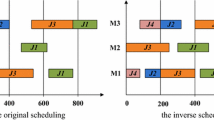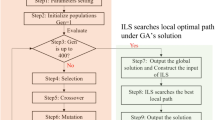Abstract
This paper investigates the single-machine inverse scheduling problem with adjusted due-dates (SISPAD) which has a strong background in practical industries. In the SISPAD, the parameters values are uncertain, and the objective is to obtain the optimal schedule sequence through minimal adjusting processing parameters or the job sequence for a promising target. First, a SISPAD mathematical model is devised to handle uncertain processing parameters and scheduling problem at the same time. Then, this paper proposes three hybrid algorithms (HVNG) that combine variable neighborhood search (VNS) algorithm and genetic algorithm by using series, parallel, and insert structure for solving the SISPAD. In the proposed HVNG, a well-designed encoding strategy is presented to achieve processing operator and job parameter simultaneous optimization. To improve the diversity and quality of the individuals, a double non-optimal scheduling method is designed to construct initial population. Compared to the fixed neighborhood structure in regular VNS, a dynamic neighborhood set update mechanism is utilized to exploit the potential search space. In addition, three different neighborhood structures are used in the HVNG algorithm. Finally, two set public problem instances are provided for the HVNG algorithm. Empirical studies demonstrate that the proposed algorithm significantly outperforms its rivals.



















Similar content being viewed by others
References
Brucker P, Shakhlevich NV (2009) Inverse scheduling with maximum lateness objective. J Sched 12(5):475–488
Heuberger C (2004) Inverse combinatorial optimization: a survey on problems, methods and results. J Comb Optim 8:329–361
Brucker P, Shakhlevich NV (2011) Inverse scheduling: two-machine flow-shop problem. J Sched 14(3):239–256
Koulamas C (2005) Inverse scheduling with controllable job parameters. Int J Serv Oper Manag 1(1):35–43
Chen RJ, Chen F, Tang GC (2005) Inverse problems of a single machine scheduling to minimize the total completion time. J Shanghai Second Polytech Univ 22(2):1–7
Chen RJ, Tang GC (2009) Inverse problems of supply chain scheduling and flow shop scheduling. Oper Res Manag Sci 18(2):80–84
Chen JF (2015) Unrelated parallel-machine scheduling to minimize total weighted completion time. J Intell Manuf 26(6):1099–1112
Pham H, Lu XW (2012) Inverse problem of total weighted completion time objective with unit processing time on identical parallel machines. J East China Univ Sci Technol 38(6):757–761
Li SS, Brucker P, Ng CT, Cheng TE, Shakhlevich NV, Yuan JJ (2013) A note on reverse scheduling with maximum lateness objective. J Sched 16(4):417–422
Li X, Gao L (2016) An effective hybrid genetic algorithm and tabu search for flexible job shop scheduling problem. Int J Prod Econ 174:93–110
Chiang TC, Cheng HC, Fu LC (2011) NNMA: an effective memetic algorithm for solving multiobjective permutation flow shop scheduling problems. Expert Syst Appl 38(5):5986–5999
Moschakis IA, Karatza HD (2015) Towards scheduling for Internet-of-Things applications on clouds: a simulated annealing approach. Concurr Comput Pract Exp 27(8):1886–1899
Yannibelli V, Amandi A (2013) Hybridizing a multi-objective simulated annealing algorithm with a multi-objective evolutionary algorithm to solve a multi-objective project scheduling problem. Expert Syst Appl 40(7):2421–2434
Xie Z, Zhang C, Shao X et al (2014) An effective hybrid teaching–learning-based optimization algorithm for permutation flow shop scheduling problem. Adv Eng Softw 77:35–47
Mladenovic N, Hansen P (1997) Variable neighborhood search. Comput Oper Res 24:1097–1100
Hansen P, Mladenović N, Moreno Pérez JA (2010) Variable neighbourhood search: methods and applications. Ann Oper Res 175:367–407
Djogatović Marko S, Stanojević Milorad J, Mladenović Nenad (2014) A variable neighborhood search particle filter for bearings-only target tracking. Comput Oper Res 52:192–202
Thomas BW, Manni E (2014) Scheduled penalty variable neighborhood search. Comput Oper Res 52(52):170–180
Li JQ, Pan QK, Wang FT (2014) A hybrid variable neighborhood search for solving the hybrid flow shop scheduling problem. Appl Soft Comput 24(24):63–77
Adibi MA, Shahrabi J (2014) A clustering-based modified variable neighborhood search algorithm for a dynamic job shop scheduling problem. Int J Adv Manuf Technol 70(9–12):1955–1961
Bilyk A, Mönch L (2012) A variable neighborhood search approach for planning and scheduling of jobs on unrelated parallel machines. J Intell Manuf 23(5):1621–1635
Karimi N, Davoudpour H (2014) A high performing metaheuristic for multi-objective flowshop scheduling problem. Comput Oper Res 52:149–156
Türkyılmaz A, Bulkan S (2015) A hybrid algorithm for total tardiness minimisation in flexible job shop: genetic algorithm with parallel VNS execution. Int J Prod Res 53(6):1832–1848
Moslehi G, Khorasanian D (2014) A hybrid variable neighborhood search algorithm for solving the limited-buffer permutation flow shop scheduling problem with the makespan criterion. Comput Oper Res 52(1):260–268
Kovačević D, Mladenović N, Petrović B et al (2014) DE-VNS: self-adaptive differential evolution with crossover neighborhood search for continuous global optimization. Comput Oper Res 52:157–169
Shao W, Pi D (2015) A self-guided differential evolution with neighborhood search for permutation flow shop scheduling. Expert Syst Appl 51:161–176
Marinakis Y, Marinaki M (2013) Particle swarm optimization with expanding neighborhood topology for the permutation flowshop scheduling problem. Soft Comput 17(7):1159–1173
Jin L, Zhang C, Shao X (2015) An effective hybrid honey bee mating optimization algorithm for integrated process planning and scheduling problems. Int J Adv Manuf Technol 80(5–8):1–12
Cui Z, Gu X (2015) An improved discrete artificial bee colony algorithm to minimize the makespan on hybrid flow shop problems. Neurocomputing 148(148):248–259
Verela R, Vela CR, Puente J, Gomez A (2003) A knowledge-based evolutionary strategy for scheduling problems with bottlenecks. Eur J Oper Res 145:57–71
Lam AYS, Li VOK (2010) Chemical-reaction-inspired metaheuristic for optimization. IEEE Trans Evol Comput 14:381–399
Jakobovic D, Budin L (2006) Dynamic scheduling with genetic programming. Lect Notes Comput Sci 3905:73–84
Lu C, Xiao S, Li X et al (2016) An effective multi-objective discrete grey wolf optimizer for a real-world scheduling problem in welding production. Adv Eng Softw 99:161–176
Acknowledgements
The authors acknowledge the National Natural Science Foundation of China (Grants: 51605267, 51775216), the Natural Science Foundation of Shandong Province, China (Grant: ZR2016EEQ07), the Colleges and Universities of Shandong Province Science and Technology Plan Projects (Grant: J16LB04), and Program for HUST Academic Frontier Youth Team.
Author information
Authors and Affiliations
Corresponding author
Ethics declarations
Conflict of interest
The authors declare that there is no conflict of interests regarding the publication of this paper.
Rights and permissions
About this article
Cite this article
Mou, J., Gao, L., Guo, Q. et al. Hybrid optimization algorithms by various structures for a real-world inverse scheduling problem with uncertain due-dates under single-machine shop systems. Neural Comput & Applic 31, 4595–4612 (2019). https://doi.org/10.1007/s00521-018-3472-7
Received:
Accepted:
Published:
Issue Date:
DOI: https://doi.org/10.1007/s00521-018-3472-7




